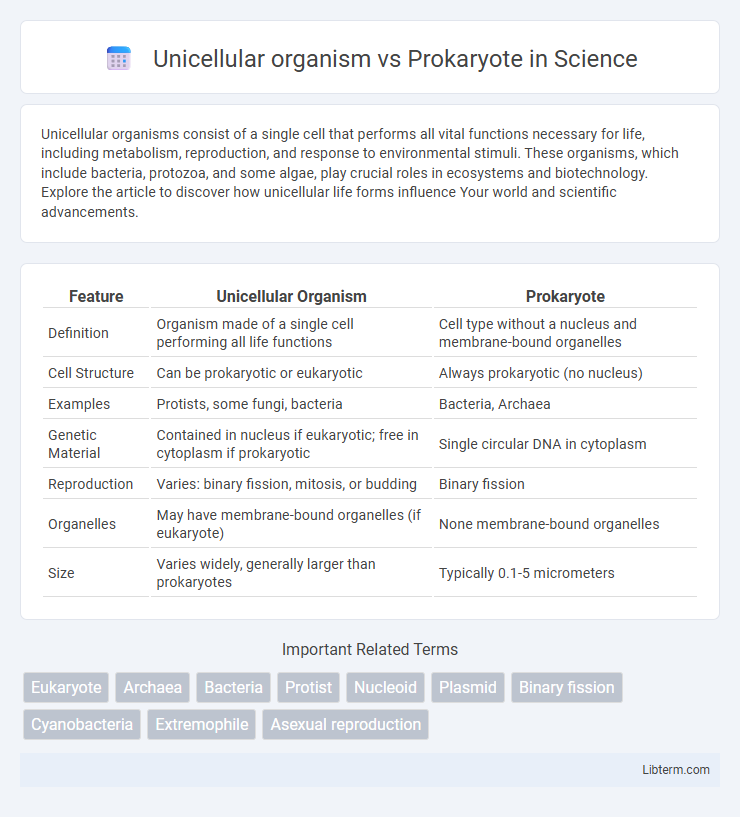Unicellular organisms consist of a single cell that performs all vital functions necessary for life, including metabolism, reproduction, and response to environmental stimuli. These organisms, which include bacteria, protozoa, and some algae, play crucial roles in ecosystems and biotechnology. Explore the article to discover how unicellular life forms influence Your world and scientific advancements.
Table of Comparison
| Feature | Unicellular Organism | Prokaryote |
|---|---|---|
| Definition | Organism made of a single cell performing all life functions | Cell type without a nucleus and membrane-bound organelles |
| Cell Structure | Can be prokaryotic or eukaryotic | Always prokaryotic (no nucleus) |
| Examples | Protists, some fungi, bacteria | Bacteria, Archaea |
| Genetic Material | Contained in nucleus if eukaryotic; free in cytoplasm if prokaryotic | Single circular DNA in cytoplasm |
| Reproduction | Varies: binary fission, mitosis, or budding | Binary fission |
| Organelles | May have membrane-bound organelles (if eukaryote) | None membrane-bound organelles |
| Size | Varies widely, generally larger than prokaryotes | Typically 0.1-5 micrometers |
Introduction to Unicellular Organisms
Unicellular organisms are single-celled life forms that carry out all biological processes within one cell, enabling them to survive, reproduce, and adapt independently. Prokaryotes, a major category of unicellular organisms, lack membrane-bound organelles and a defined nucleus, distinguishing them from eukaryotic unicellular organisms. These microorganisms include bacteria and archaea, playing essential roles in ecosystems, biotechnology, and human health.
Defining Prokaryotes
Prokaryotes are unicellular organisms characterized by the absence of a nucleus and membrane-bound organelles, distinguishing them from eukaryotic cells. These organisms, including bacteria and archaea, possess a simple cell structure with genetic material organized in a nucleoid region. Prokaryotes exhibit diverse metabolic pathways and inhabit various environments, playing crucial roles in ecological systems and biogeochemical cycles.
Key Differences Between Unicellular Organisms and Prokaryotes
Unicellular organisms encompass both prokaryotes and eukaryotes, distinguished primarily by cellular complexity and genetic organization. Prokaryotes, such as bacteria and archaea, lack a nucleus and membrane-bound organelles, whereas unicellular eukaryotes like amoebae have defined nuclei and organelles. The genetic material in prokaryotes is typically a single circular chromosome located in the nucleoid region, contrasting with the multiple linear chromosomes enclosed within the nucleus of eukaryotic unicellular organisms.
Eukaryotic Unicellular Life Forms
Eukaryotic unicellular organisms, such as amoebae and certain algae, possess membrane-bound organelles and a defined nucleus, distinguishing them from prokaryotes, which lack these features. Unlike prokaryotes, eukaryotic single-celled life forms exhibit complex cellular processes including mitosis and advanced intracellular trafficking. These characteristics enable eukaryotic unicellular organisms to perform specialized functions and adapt to diverse environments more effectively than prokaryotic cells.
Cellular Structure Comparison
Unicellular organisms can be either prokaryotes or eukaryotes, but prokaryotes specifically lack membrane-bound organelles such as a nucleus, mitochondria, and endoplasmic reticulum. The cellular structure of prokaryotes, including bacteria and archaea, consists of a single circular chromosome located in the nucleoid region, while unicellular eukaryotes possess multiple linear chromosomes enclosed within a true nucleus. Prokaryotic cells typically have a rigid cell wall composed of peptidoglycan, whereas many unicellular eukaryotes have flexible membranes or complex cell walls containing cellulose or chitin.
Genetic Material Organization
Unicellular organisms can be either prokaryotes or eukaryotes, with distinct genetic material organization. Prokaryotes, such as bacteria and archaea, lack a membrane-bound nucleus, and their circular DNA resides freely within the cytoplasm in a nucleoid region. In contrast, eukaryotic unicellular organisms have linear chromosomes enclosed within a defined nucleus, with complex chromatin structure allowing for regulated gene expression.
Modes of Reproduction
Unicellular organisms reproduce primarily through asexual methods such as binary fission, budding, or spore formation, enabling rapid population growth. Prokaryotes, a subset of unicellular organisms including bacteria and archaea, reproduce mainly via binary fission, where the DNA replicates and the cell divides into two identical daughter cells. Horizontal gene transfer mechanisms like conjugation, transformation, and transduction also play crucial roles in prokaryotic genetic diversity beyond simple reproduction.
Metabolic Diversity
Prokaryotes exhibit remarkable metabolic diversity, including aerobic respiration, anaerobic respiration, fermentation, photosynthesis, and chemosynthesis, enabling them to inhabit various environments. Unicellular organisms, a broader category that includes both prokaryotes and eukaryotes, display varied metabolic pathways but often rely on simpler energy acquisition processes compared to more complex multicellular life forms. Metabolic versatility in prokaryotes, such as nitrogen fixation by cyanobacteria and methanogenesis by archaea, highlights their crucial roles in global biogeochemical cycles.
Evolutionary Perspectives
Unicellular organisms encompass both prokaryotes and eukaryotes, with prokaryotes representing the earliest and most ancient forms of life, dating back approximately 3.5 billion years. Evolutionarily, prokaryotes exhibit simpler cell structures lacking membrane-bound organelles, which allowed rapid adaptation and diversification in primordial environments. This simplicity laid the foundation for the emergence of more complex unicellular eukaryotes, driving major evolutionary transitions toward multicellularity and increased cellular complexity.
Significance in Ecology and Biotechnology
Unicellular organisms, including prokaryotes, play crucial roles in nutrient cycling, such as nitrogen fixation and carbon decomposition, maintaining ecosystem stability. Prokaryotes like bacteria are extensively utilized in biotechnology for applications including genetic engineering, bioremediation, and the production of antibiotics. Their metabolic diversity and rapid reproduction rates enable innovative solutions in environmental management and industrial biotechnology.
Unicellular organism Infographic

 libterm.com
libterm.com